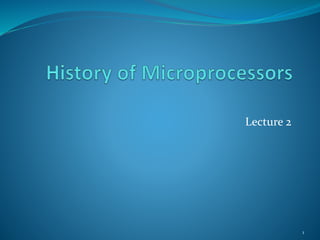
History of microprocessors copy
- 1. Lecture 2 1
- 2. Generation of Microprocessors We divide the years of development of microprocessors as 5 generations From 1970 to date 2
- 3. First generation (1971 – 73) Intel Corporation introduced 4004, the first microprocessor in 1971. During the same period: Rockwell International’s PPS-4 (4 bits) Intel’s 8008 (8 bits) National Semiconductor’s IMP-16 (16 bits) They were fabricated using PMOS technology which provided low cost, slow speed and low output currents They were not compatible with TTL 3
- 4. Second Generation (1974 – 1978) Marked the beginning of very efficient 8 – bit microprocessors. Some of the popular processors were: Motorola’s 6800 and 6809 Intel’s 8085 Zilog’s Z80 They were manufactured using NMOS technology. This technology offered faster speed and higher density than PMOS TTL compatible 4
- 5. Third generation microprocessors (1979 – 80) This age dominated by 16 – bits microprocessors Some of them were: Intel’s 8086/80186/80286 Motorolla’s 68000/68010 They were designed using HMOS technology HMOS provides some advantages over NMOS as Speed-power-product of HMOS is four times better than that of NMOS HMOS can accommodate twice the circuit density compared to NMOS Intel used HMOS technology to recreate 8085A and named it as 8085AH with a higher price tag. 5
- 6. Fourth Generation (1981 – 1995) This era marked the beginning of 32 bits microprocessors Intel introduced 432, which was bit problematic a clean Intel 80386 is launched. Motorola introduced 68020/68030. They were fabricated using low-power version of the HMOS technology called HCMOS. Motorola introduced 32-bit RISC processors called MC88100 6
- 7. Fifth Generation (1995 – till date) This age the emphasis is on introducing chips that carry on-chip functionalities and improvements in the speed of memory and I/O devices along with introduction of 64-bit microprocessors. Intel leads the show here with Pentium, Celeron and very recently dual and quad core processors working with up to 3.5GHz speed. 7
- 8. Evolution of Intel Microprocessors 4-bit 8-bit 16-bit 32-bit 64-bit 4004 8008 8086 80386 Dual Core 4040 8080 8088 80486 Core 2 8085 80186 Pentium/80586 Core i7 80188 PII Core i5 80286 PIII Core i3 PIV Dual Core 8
- 9. INTEL 4004 the first microprocessor by Intel. Its clock speed was 740KHz. It had 2,300 transistors. It could execute around 60,000 instructions per second. Bus width: 4 bits 4 KB program memory 640 bytes data memory No interrupts 16-pin DIP (Dual Inline Package) 9
- 10. 10
- 11. INTEL 8080 Introduced in 1974. 8-bit microprocessor. clock speed 2 MHz. It had 6,000 transistors. 10 times faster than 8008. execute 5,00,000 instructions per second. 11
- 12. 12
- 13. INTEL 8085 Introduced in 1976. 8-bit μP. Its clock speed 3 MHz. Its data bus is 8-bit and address bus is 16-bit. It had 6,500 transistors. Could execute 7,69,230 instructions per second. It could access 64 KB of memory. It had 246 instructions. Over 100 million copies were sold. 13
- 14. 14
- 15. INTEL 8086 Introduced in 1978. It was first 16-bit μP. Its clock speed is 4.77 MHz, 8 MHz and 10 MHz, depending on the version. Its data bus is 16-bit and address bus is 20-bit. It had 29,000 transistors. Could execute 2.5 million instructions per second. It can access 1 MB of memory. It has 22,000 instructions. It had Multiply and Divide instructions. 15
- 16. 16
- 17. INTEL 8088 Introduced in 1979. It was also 16-bit μP. It was created as a cheaper version of Intel’s 8086. It was a 16-bit processor with an 8-bit external bus. Could execute 2.5 million instructions per second. This chip became the most popular in the computer industry when IBM used it for its first PC. 8088 and 8086 functionally identical but 8088 lower performance, 17
- 18. 18
- 19. INTEL 80386 Introduced in 1986. first 32-bit μP. Its data bus is 32-bit and address bus is 32-bit. It could address 4 GB of memory. It had 2,75,000 transistors. Its clock speed varied from 16 MHz to 33 MHz depending upon the various versions. Different versions: 80386 DX 80386 SX 80386 SL Intel 80386 became the best selling microprocessor in history. 83086 has various operation mode, which allow it to act as 80286 chip or multiple 8086 chip, as well as a set of instruction capable of 32 bit operations such as arithmetic. 19
- 20. 20
- 21. INTEL PENTIUM IV Introduced in 2000. 32-bit μP. Its clock speed was from 1.3 GHz to 3.8 GHz. L1 cache was of 32 KB & L2 cache of 256 KB. It had 42 million transistors. All internal connections were made from aluminum to copper. 21
- 22. 22
- 23. INTEL DUAL CORE Introduced in 2006. It is 32-bit or 64-bit μP. It has two cores. Both the cores have their own internal bus and L1 cache, but share the external bus and L2 cache It supported SMT technology. SMT: Simultaneously Multi-Threading E.g.: Adobe Photoshop supported SMT 23
- 24. INTEL CORE 2 Introduced in 2006. It is a 64-bit μP. Its clock speed is from 1.2 GHz to 3 GHz. It has 291 million transistors. It has 64 KB of L1 cache per core and 4 MB of L2 cache. It is launched in three different versions: Intel Core 2 Duo Intel Core 2 Quad Intel Core 2 Extreme 24
- 25. 25
- 26. INTEL CORE i3 Introduced in 2010. It is a 64-bit μP. It has 2 physical cores. Its clock speed is from 2.93 GHz to 3.33 GHz. It has 781 million transistors. It has 64 KB of L1 cache per core, 512 KB of L2 cache and 4 MB of L3cache 26
- 27. Other processors Mobile Pentium processors Atom processors 27